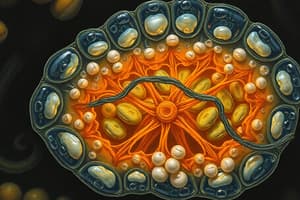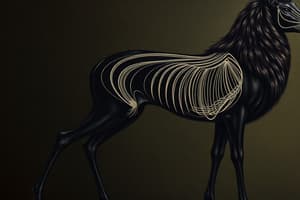Podcast
Questions and Answers
What is an animal?
What is an animal?
Animals are eukaryotic and multicellular organisms that are heterotrophic, feeding on organic material and digesting it internally.
All animals are motile during their entire life cycle.
All animals are motile during their entire life cycle.
False (B)
Which of the following are characteristics of animals?
Which of the following are characteristics of animals?
- Cell with nucleus (correct)
- Autotrophic
- Heterotrophic (correct)
- Multicellular (correct)
The blastula stage in embryonic development is unique to __________.
The blastula stage in embryonic development is unique to __________.
Which kingdom includes animals?
Which kingdom includes animals?
What does the term 'Archetype' refer to in biology?
What does the term 'Archetype' refer to in biology?
What is the significance of the phylogenetic tree in zoology?
What is the significance of the phylogenetic tree in zoology?
Aerobic respiration is a characteristic of all animals.
Aerobic respiration is a characteristic of all animals.
Match the following terms with their definitions:
Match the following terms with their definitions:
Flashcards are hidden until you start studying
Study Notes
Animal Architecture
- Animals are eukaryotic, multicellular organisms primarily classified under the kingdom Animalia.
- They are heterotrophic, obtaining nutrients from organic material, unlike autotrophic plants and algae that synthesize their own food.
- Most animals respire aerobically, with a few exceptions.
Definitions and Characteristics
- All animals exhibit motility, moving spontaneously during part of their life cycle; some later become sessile.
- The blastula stage, unique to animals, enables the differentiation of cells into specialized tissues and organs during embryonic development.
- Key features distinguishing animals from other life forms include having a nucleus in their cells, being multicellular, heterotrophic, and possessing motility at some life stage.
Animal Taxonomy and Phylogeny
- Animals belong to the domain Eukarya, sharing certain characteristics with fungi, plants, protists, and bacteria.
- The phylogenetic tree categorizes life forms with Animalia being a significant branch that evolved from protist-like ancestors.
- Parazoa and Eumetazoa are subcategories; Parazoa includes sponges (Porifera), while Eumetazoa encompasses most animals with tissues.
Archetype in Animal Biology
- An archetype represents a foundational body plan that influences the shapes and forms of later evolutionary descendants.
- Once established, an archetype restricts body shape variations, maintaining consistency within its evolutionary lineage.
- According to Richard Owen (1847), the vertebrate archetype serves as a model from which various vertebrate forms derive, showing evolutionary patterns.
Complexity and Development
- Architectural patterns in animals arise from their complexity and body size, influencing their evolutionary adaptations.
- The study of animal architecture includes examining the principles and features that define the structural complexity of animal forms.
- Body plans are derived innovations that allow organisms to adapt to different environments while preserving essential physiological functions.
Studying That Suits You
Use AI to generate personalized quizzes and flashcards to suit your learning preferences.




